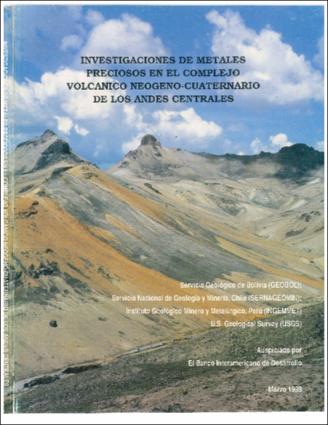Please use this identifier to cite or link to this item:
https://hdl.handle.net/20.500.12544/4932Precious metal deposits in the Neogene-Quaternary Volcanic complex of the Central Andes
Mar-1993
Investigaciones de metales preciosos en el complejo volcánico Neógeno-Cuaternario de los Andes Centrales
The Neogene-Quarernary volcanic complex of thc central Andes contains hundreds of hydrothermally altered zones, severa! of which are associated with world-dass cpichcrmal precious-metal deposits, but most of which are either unexplored or inadcquately explorcd. Thcse young volcanic rocks, chiefly andesitic to dacitic lavas and rhyolitic ash-ílow tuffs, ·extenct· over an area of about 300,000 km2 in the Andean Highlands of southern Perú, northcrn Chile, western Bolivia, and northwestern Argentina. At least a dozen majar deposits have been discovered in che young volcanic complex since the late 1970's by exploration programs stimulated by the phenomenal rise in gold and silver prices. Not only are eruptive centers in che complex prime exploration targets, but thc volcanic complcx covers older rocks and associated mineral deposits of one of the world's greatcst metallogenic provinces. Future exploration should reveal the presence of more deposits both within and beneath the volcanic rocks. The volcanic-hosted epithermal precious-metal dcposits are spatially and temporally related to eruptive centers--stratovolcanoes, calderas, and domes--within the volcanic complex. Included are both adularia-sericite and acid-sulíate types of deposits for which distinct sub-types can be distinguished and corresponding descriptive modcls constructcd. Adularia-sericite-type deposits include (1) silver-rich polymetallic base-metal veins, (2) polymetallic tin-silver-rich veins, and (3) stockwork porphyry deposits. Acid-sulfate-type deposits, which are charactcrizcd by che presencc of enargite and magmatichydrothermal alunice, includc (1) silver- and gold-silvcr-rich polymctallic base-metal veins and (2) lowgrade vuggy silica and breccia gold-silver dcposits. Radiometric ages show that most of the precious-metal deposits are of middle Miocene age (17-9 Ma), but severa! are as young as Pliocene and Pleistocene (5-1.2 Ma), and others may be forming today in association with active thermal spring systems and fumarolic-srage stratovolcanoes. Grade and tonnage data íor both high-gradc (gencrally mulli-vein) dcposits and low-grade (generally stockwork or vuggy silica) dcposits show that most contain bctween 500 and 5,000 metric tons (t) of silver and lcss than 60 t of gold. Cerro Rico de Potosí, a polymctallic tin-silver deposit, is the world's largest silver deposit, having produced an cstimatcd 30,000 t of silver from ores that probably averaged more than 500 grams per metric ton (g/t) silver. A comparable amount of silvcr is estimated to remain in Cerro Rico in veins and stockworks, disseminated into the wallrock, and in waste dumps, ali having grades of 150-250 g/t silver. Silver-rich base-metal ores generally contain 500 or more g/t silver bue less than 2 g/t gold; ore shoots in sorne veins may contain 100 or more g/t gold. Thc richcst gold ore reccntly found in the central Andes has bcen the 3500 vein of the El Indio district, Chile, which has yielded about 30 t of gold from ores averaging about 250 g/t gol d. Significanc amounts of the ore in this vein contain more tan 1,000 g/t gold. Low-grade stockwork, vuggy silica, and brcccia dcposits, of which at least a dozcn have been discovered during the 1980's and 4 or 5 are currenLly in operalion, havc average grades on the arder of 1.5-2 g/t gold and 20-100 g/t silver. Resources of such deposits rangc from 25 to 60 t of gold and to as much as 3,000 t of silver.
Servicio Geológico de Bolivia
Ericksen, G. & Cunningham, C. (1993). Precious metal deposits in the Neogene-Quaternary Volcanic complex of the Central Andes. En: Servicio Geológico de Bolivia, Servicio Nacional de Geología y Minería, Chile, Instituto Geológico Minero y Metalúrgico, Perú & U.S Geological Survey, Investigaciones de metales preciosos en el complejo volcánico Neógeno-Cuaternario de los Andes Centrales. La Paz: Servicio Geológico de Bolivia, pp. 3-16.
14 páginas
Files in This Item:
| File | Description | Size | Format | |
|---|---|---|---|---|
| Ericken-Precious_metal_Central_Andes--.pdf | 21.8 MB | Adobe PDF | View/Open |
This item is licensed under a Creative Commons License












